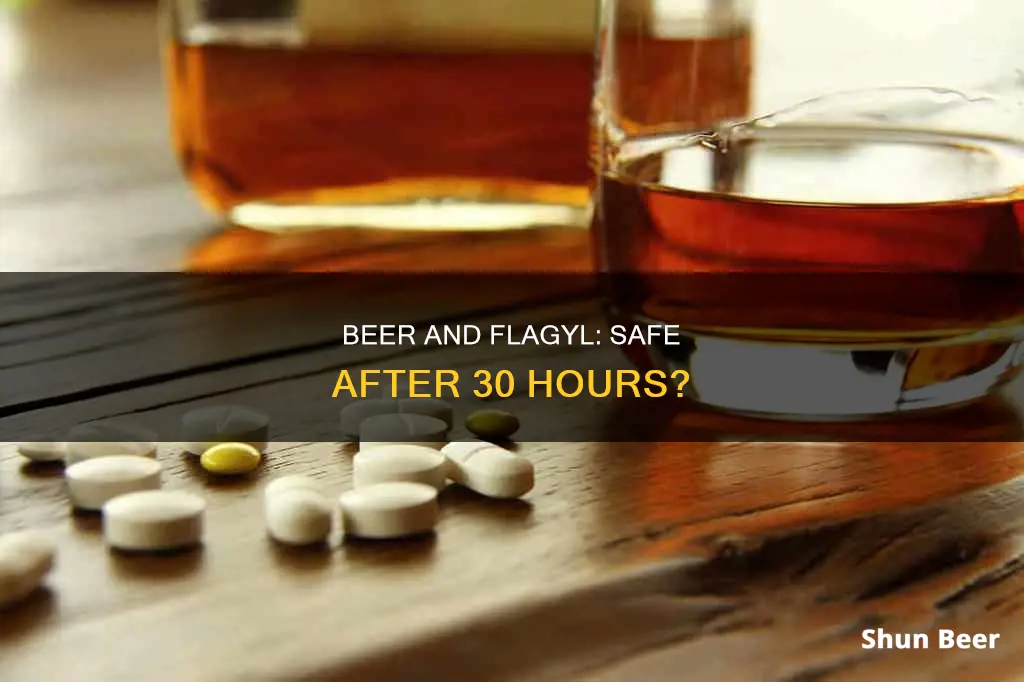
Flagyl, or metronidazole, is an antibiotic used to treat a variety of bacterial infections. While it is a common and effective medication, it is well-known that it should not be combined with alcohol. Drinking alcohol while taking metronidazole can cause a range of side effects, from mild to severe, including flushing, headaches, nausea, vomiting, stomach cramps, rapid heart rate, low blood pressure, and even liver damage. There has even been a reported death associated with this combination. To be safe, it is recommended to avoid alcohol for at least 3 days after finishing a course of metronidazole treatment. So, can you drink a beer 30 hours after finishing Flagyl? The answer is no—it's best to wait at least 3 days to be safe and avoid any potential negative side effects.
| Characteristics | Values |
|---|---|
| Recommended waiting time after finishing Flagyl | 3 days |
| Waiting time for people applying metronidazole products to their skin or using the vaginal gel | 24 hours |
| Side effects of combining Flagyl and alcohol | Flushing, headaches, nausea, vomiting, stomach cramps, rapid heart rate, liver damage, low blood pressure, blurred vision, colour perception changes |
What You'll Learn
- It is recommended to wait at least 3 days after finishing Flagyl before drinking alcohol
- Mixing Flagyl and alcohol may cause a disulfiram-like reaction
- Side effects of this reaction include flushing, headaches, nausea, vomiting, and stomach cramps
- There is controversy around this reaction, as some studies have shown serious problems, while others have shown no interaction
- Flagyl is an antibiotic that treats various infections, including abdominal and sexually transmitted infections

It is recommended to wait at least 3 days after finishing Flagyl before drinking alcohol
The disulfiram-like reaction occurs when Flagyl blocks the enzyme aldehyde dehydrogenase, which is responsible for breaking down a toxic compound called acetaldehyde—produced when the body metabolizes alcohol. This blockage can lead to a buildup of acetaldehyde in the bloodstream, resulting in symptoms such as skin redness, palpitations, nausea, vomiting, headache, and in severe cases, a dangerous rapid heart rate or a sudden drop in blood pressure.
While not everyone will experience this reaction, it is challenging to predict who is at risk. Therefore, healthcare professionals advise abstaining from alcohol for at least 3 days after completing a course of Flagyl. This allows ample time for the body to fully metabolize the drug and reduce the risk of adverse effects.
It is important to note that Flagyl is a common antibiotic prescribed for various infections, including skin infections, bacterial vaginosis, and pelvic inflammatory disease. It is available in different forms, such as tablets, vaginal gels, and topical creams. While Flagyl is effective in treating these conditions, it is crucial to follow the prescribed regimen and avoid alcohol consumption during and for a few days after the treatment to ensure its effectiveness and prevent any potential health risks.
Beer and Diabetes: Can Diabetics Drink in Moderation?
You may want to see also

Mixing Flagyl and alcohol may cause a disulfiram-like reaction
Flagyl, also known as Metronidazole, is an antibiotic used to treat many infections, including abdominal and sexually transmitted infections (STIs). While it is a common and effective medication, it is important to be aware of its potential interactions with other substances, such as alcohol.
Mixing Flagyl and alcohol can lead to a disulfiram-like reaction, which may cause a range of mild to moderate side effects. This reaction occurs due to the way alcohol is metabolised in the body. When a person consumes alcohol, the body breaks it down in two steps. Firstly, alcohol is converted into a compound called acetaldehyde, which is toxic and responsible for many of alcohol's unwanted effects. The body then reduces acetaldehyde to acetate with the help of an enzyme called aldehyde dehydrogenase.
Flagyl interacts with this process by blocking the aldehyde dehydrogenase enzyme, leading to a buildup of acetaldehyde in the bloodstream. This accumulation of acetaldehyde can result in a disulfiram-like reaction, causing symptoms such as:
- Flushing of the face
- Headaches
- Nausea
- Vomiting
- Stomach cramps
- Abdominal pain
- Rapid heart rate
- Low blood pressure
- Liver damage
It is important to note that these reactions do not occur in all individuals, and the exact mechanism behind this variation is not yet fully understood. However, due to the potential severity of these side effects, healthcare professionals recommend avoiding alcohol entirely while using Flagyl in any form. This includes both oral and topical applications of the medication. The recommended period for abstaining from alcohol is typically three days after the last dose of Flagyl to ensure the medication has cleared the system.
In summary, mixing Flagyl and alcohol may cause a disulfiram-like reaction, leading to a range of mild to severe side effects. To avoid these potential health risks, it is best to refrain from consuming alcohol during and for a few days after completing Flagyl treatment.
Beer and Intermittent Fasting: What You Need to Know
You may want to see also

Side effects of this reaction include flushing, headaches, nausea, vomiting, and stomach cramps
Drinking alcohol while taking metronidazole (Flagyl) is not recommended because the combination can cause a disulfiram-like reaction in some people. This reaction includes side effects such as flushing, headaches, nausea, vomiting, and stomach cramps.
The disulfiram-like reaction occurs when alcohol is broken down into a compound called acetaldehyde, which is responsible for the unwanted effects of alcohol, such as nausea and flushing. Normally, the body then reduces acetaldehyde to acetate, which is then breathed out as carbon dioxide. However, in this reaction, the breakdown of acetaldehyde is blocked, leading to a buildup that causes symptoms such as skin redness, palpitations, nausea, vomiting, and headache. In severe cases, it can also cause a rapid heart rate or a sudden drop in blood pressure.
While there is some controversy around the interaction between metronidazole and alcohol, with some studies finding little to no evidence of the reaction, it is still best to err on the side of caution and avoid alcohol while taking the medication and for at least 3 days after finishing the course.
Orthodox Christians: Beer During Fasting, Allowed or Not?
You may want to see also

There is controversy around this reaction, as some studies have shown serious problems, while others have shown no interaction
There is a lot of controversy surrounding the interaction between Flagyl (metronidazole) and alcohol. While some studies have shown that this combination can cause serious problems, others have shown that there is no interaction between the two substances. Flagyl is a common antibiotic often sold under the brand name Flagyl and is used to treat a variety of bacterial infections. It is generally recommended that people avoid consuming alcohol while taking Flagyl as there have been reports of serious side effects. However, not everyone will have a negative reaction when combining alcohol and Flagyl.
The controversy stems from the fact that some studies have found evidence of a disulfiram-like reaction between Flagyl and alcohol, while others have found the existence of this interaction to be absent or weak. A disulfiram-like reaction can cause severe side effects such as nausea, vomiting, headaches, skin redness, palpitations, and in severe cases, a dangerous rapid heart rate or a sudden drop in blood pressure. This type of reaction occurs when Flagyl blocks the enzyme aldehyde dehydrogenase, leading to a buildup of acetaldehyde in the body. Acetaldehyde is a toxic compound responsible for many of alcohol's unwanted effects, such as nausea, vomiting, and flushing.
However, several studies have investigated the reaction between Flagyl and alcohol and have found little to no evidence of this interaction. It is possible that the concern over this interaction is overstated and that the reaction could just be a side effect of Flagyl itself or only occur in a small subgroup of susceptible people. Additionally, large clinical trials in humans have never been conducted to confirm the interaction, so there is still a lot of uncertainty.
Due to the potential risks and the lack of clear-cut research, healthcare professionals generally recommend avoiding alcohol while taking Flagyl and for at least 48 hours to 3 days after finishing the course of treatment. This allows ample time for the body to fully metabolize the drug and reduce the risk of adverse effects. However, the length of time one should wait before drinking alcohol again may depend on various factors, including dosage, duration of treatment, and individual differences in metabolizing the medication.
While not everyone may experience negative side effects when mixing alcohol and Flagyl, it is important to prioritize health and follow the prescribed regimen to ensure the treatment's effectiveness. If you have any concerns or questions about drinking alcohol after finishing Flagyl, it is always best to consult with a healthcare professional.
Beer and Clindamycin: Is It Safe to Mix?
You may want to see also

Flagyl is an antibiotic that treats various infections, including abdominal and sexually transmitted infections
Flagyl, or metronidazole, is an antibiotic used to treat a wide range of bacterial infections. It works by stopping the growth of certain bacteria and parasites. It is commonly used to treat bacterial infections of the vagina, stomach, liver, skin, joints, brain and spinal cord, lungs, heart, or bloodstream. It is also used to treat trichomoniasis, a sexually transmitted infection caused by a parasite.
Flagyl is a synthetic nitroimidazole antimicrobial, specifically, 2-methyl-5-nitro-1H-imidazole-1-ethanol. It is available as an oral tablet, a vaginal suppository, and a topical cream. The usual adult dosage is 7.5 mg/kg every six hours, not exceeding 4g in a 24-hour period. The length of treatment is typically 7 to 10 days, but this can vary depending on the type of infection.
It is important to note that Flagyl should not be used to treat viral infections, such as the common cold or flu, and it is not suitable for treating most cases of acute diarrhea. Additionally, Flagyl should be used with caution during pregnancy and breastfeeding, and it may interact with other medications, including blood thinners and disulfiram.
One of the most important considerations when taking Flagyl is avoiding alcohol consumption. Drinking alcohol while taking Flagyl or within three days of finishing the medication can cause a disulfiram-like reaction, leading to severe side effects such as flushing, headaches, nausea, vomiting, stomach cramps, rapid heart rate, and liver damage. Therefore, it is strongly recommended to refrain from alcohol consumption during and for at least three days after completing the course of Flagyl treatment.
Beer and Drunkenness: One Beer, Tipsy or Sober?
You may want to see also
Frequently asked questions
It is not recommended to consume alcohol within 72 hours of finishing a course of Flagyl.
Flagyl is an antibiotic that treats many infections, including abdominal, sexually transmitted, skin, bone and joint, central nervous system, respiratory, and heart infections. It is also used to treat bacterial vaginosis and pelvic inflammatory disease.
Drinking alcohol while taking Flagyl can cause a disulfiram-like reaction, leading to side effects such as flushing, headaches, nausea, vomiting, stomach cramps, rapid heart rate, low blood pressure, liver damage, and blurred vision. There has been one reported death associated with this reaction.
The half-life of Flagyl is typically around 8 to 10 hours in healthy individuals. This means that after 30 hours, approximately 93.75% to 96.88% of the drug has been eliminated from your system.
Yes, there are other antibiotics that do not interact with alcohol. However, it is important to consult your doctor or healthcare provider to determine the most appropriate treatment option for your specific condition.







